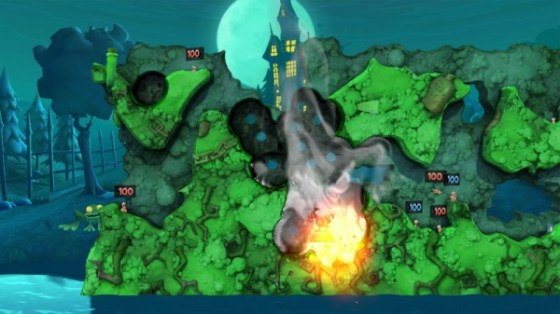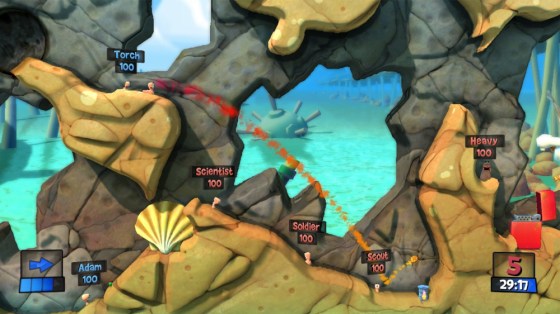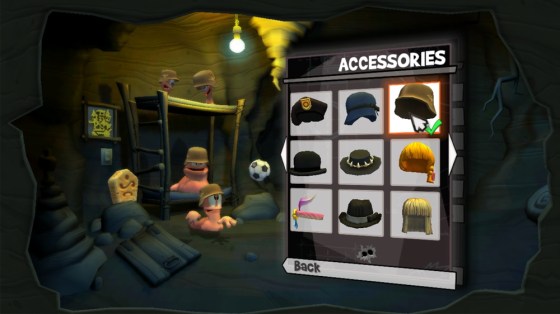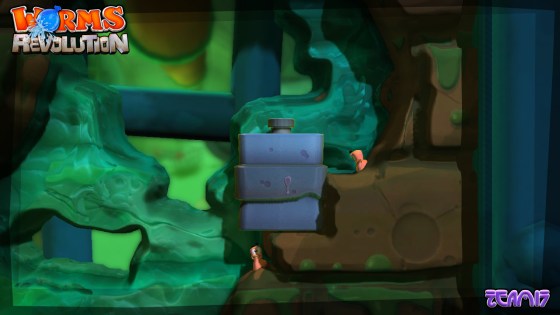Platforms: Xbox 360, Playstation 3 and PC.
Reviewed On: Xbox 360
Publisher: Team17
Developer: Team17
Singleplayer: Yes
Multiplayer: Yes
Thanks to Team17 for providing a copy of this game for review.
Usually the name’s of games are something of a throwaway, but sometimes they have an actual meaning or clear intent behind them. And it’s clear from the name of their latest game that Team17 wanted to bring back their 17-year old Worms franchise in a big way. And rightly so: over the past 17-years we’ve had a total of 16 Worms games, and throughout the majority of them the formula has remained pretty much the same. And so Team17 named their new game Worms: Revolution, a bold statement indeed. It sort of sucks that Worms: Revolution isn’t a revolution, then. It’s just Worms. Still fun Worms, but Worms nonetheless.
But hold on, let’s assume for a second that you’ve somehow never played a Worms game in the 17-years they’ve been around, entertaining us with explosive mayhem. The entire premise of the game is that two or more teams of four worms each use a variety of weapons to blow the living crap out of each other in turn-based combat on a 2D landscape. Except for that time when they attempted to make Worms into a 3D game. It didn’t go all that well. It might sound like a simplistic concept to the uninitiated, and that’s because it is. What, you thought I was going to say it was some deep, complex series that redefined strategy games? It’s worms using insane weapons, such as old , concrete donkeys and sheep to blow each other up for our personal amusement. At most the turn-based gameplay offers some tactical room, but mostly it’s just about blowing stuff up as the little worms voice hilarious little comes. It’s about having chaotic, violent, unbalanced, messy fun.
So, what are the new changes that Team17 have implemented to try to re-energize their ailing series? The first is the introduction of a class system into the game in an attempt to bring a little more depth to the core gameplay. There’s a total of four classes of worm available in the game for you to choose from; Scientists can’t take a lot of damage but they can slowly increase your teams health; Scouts can fit in small tunnels that others can’t and can also leap large distances; Heavies can take and deal out extra damage, and the Soldier is pretty much the standard Worms….er, worm that we’ve been playing as all these years. In the customisation menu you can put together squads of Worms to suit your playstyle. And of course in true Worms fashion you can also use the customisation menu to give your Worms names, goofy hats and assign them an even goofier speech styles, like the newly introduced Memes style which has them spouting meme quotes during battle. There’s a fairly large amount of stuff to choose from for your worms to wear into battle, although it’s a shame that you can’t have them wear more than one thing at a time, like a hat and a beard. In a stupid way it’s easy to get attached to your little named and dressed minions, and even feel a little sad when the get their heads blown off by a shotgun from across the map. Never mind, though, because you can also pick out their gravestone!
While the inclusion of classes is a pretty neat idea on paper, in practice it doesn’t actually alter the core gameplay all that much. The importance of classes is further lessened because outside of the games rather meaty singleplayer campaign the levels you play on are randomly generated after you’ve chosen the squad of worms you’ll be taking into battle, meaning you can’t choose your squad based on the terrain layout that you’ll be playing on. Random generation of levels can can be turned off, but you still can’t choose the level until after you’ve selected your squad, mean you’ve either got to look at the level and jump back to the selection menu, or you’re going to have to learn them off by heart and never touch the randomly generated ones. It’s entirely irritating and demonstrates a lack of common sense in the design process.
To be entirely fair to Team 17, however, it’s still nice to actually have the option of different classes in the game, and while they’re not implemented as well as I would have liked and don’t change the core gameplay as much as they should, they do at least bring a little more customisation to the game. Oh, and if you decide to purchase Revolution, give Deathmatch a go with nothing but Scouts – it’s good fun.
At least your various class of worms still have access to a massive armory of weapons and tools with which to cause destruction and pain. The Worm’s series has always been famous for its weapons that ranged from simple shotguns to flying sheep and Holy Hand Grenades, and Worms: Revolution is no different, offering up a selection of weapons that’ll be instantly familiar to anyone that’s played the series before. All the classics are here: old ladies, bazookas, grenades, airstrikes, jetpacks, baseball bats, dynamite, fire-punches and loads more! And much like the previous games in the series there’s some balancing issues with the weapons, although to be fair this is pretty much par for the course with the Worms series: it’s all about using those big, overpowered toys to cause some carnage, after all. Still, there’s some definite tweaks to be made as some weapons feel a little useless in comparison to others. Aiming, firing and using these various tools of death remain largely the same: you just go into the inventory menu, select what you want and then proceed to blow crap up. Certain toys like grenades and bazookas require you to hold down A to charge the strength of the shot or throw.
What has changed, though, is the physics engine powering these weapons has been completely revamped along with the games new graphical style (more on that later) and the result is that Worms weapons now feel more realistic, which is bloody blasphemy in this gamers eyes. Judging exact shots in Worms was always a mixture of luck and skill, but the physics engine was forgiving, allowing you to take pot shots at each other across the map with the Worms player’s weapon of choice: the bazooka. Now, though, bazooka shots have so much weight behind them that judging shots has become a far trickier process than before, and even the strongest shots barely seem to have any power behind them. Things like grenades are likewise effected, making tossing them around far less fun than before. While I applaud Team17 for trying to change their series to stay relevent, the new physics make the gameplay feel weak in comparison to previous entries in the series.
But the worst affected by the new physics engine is the beloved Ninja Rope, the transport of choice for Worms veterans in the past because of its bonkers behavior. On the one hand it was, by all accounts, a glitchy mess that defied all common sense, but in a strange way that’s why it became such a fun way of getting around: not only could you swing across levels like a deranged spider-man, but it’s gravity defying abilities also allowed you to climb up and over objects using a strange, bouncing method. This new rope, however, is a complete drag to use. The new physics engine coupled with a stupidly awkward control setup for the rope have made swinging around the level both irritatingly hard and entirely dull. No longer do you gracefully swing across the landscape, whooping your delight and raining down death, instead you just crash into the side of a cliff and decide that just trying once again to master the new weapons physics would probably be an easier of dispatching the enemy.
Most of the new toys and utilities introduced into Worms: Revolution’s armory revolve around the other two new features that Team17 have worked into their game: physics objects and water. The concept behind the physics objects is that these objects are spread across the playing field and can be manipulated in various ways, whether it be by simply shooting them or by using one of the new utilities such as telekinesis to move them around the level. Shoot a bottle of water and it’ll unleash its contents on your hapless enemies, or shoot a lighter and it’ll explode, delivering fiery death to your foes. On paper this all sounds like a pretty neat concept, allowing you to block in opponents or create defensive barriers for your team, drench opponents and blow ’em up. In practice, however, they don’t add a whole lot to the game, usually proving to be too much of a hassle to utilise over other tools in your arsenal, especially since blowing up objects seems entirely random: shoot a bottle of water and it might explode, or it might not. There’s seems to be no logic to it all, meaning you could find yourself wasting a turn in an empty attempt to detonate a lighter.
Water, on the other hand, proves to be a great new addition to the long-running series, bringing around some new tricks to abuse during play. veterans of the franchise are probably flinching: we’ve been trained to know that water means instant death, but now in Revolution there’s two kinds of liquidy substance – the normal, deadly water that inhabits the zone outside of every level, ready to inflict insta-death on any worm unfortunate enough to be punted, shot or fireballed into it, and then there’s the strangely jelly-like “water” that can be found in little pockets or in H20 bottles in levels. This water doesn’t equal instant death, instead any worm that finds himself or herself in it will start to lose health and have restricted movement, turning it into a liquid death-trap. And of course water can also wash away unfortunate worms to their doom. As said, though, this “water” does act rather strangely, moving in a fashion that more resembles jelly than H20: it slowly globs down slopes rather than running down them as one would expect of water, sits on the edges of curved hills and otherwise generally just behaves in strange and often unpredictable ways. And this can cause a few gameplay problems such as your carefully executed plan failing because the water refuses to obey the laws of physics which your brain tells you it must. Still, this flaw aside the water brings a whole new danger into the game and opens up a range of new options, not least of which are the new water-based tools at your disposal, such as the water pistol, water bomb and water-strike. There’s nothing quite like herding some enemy worms into a massive crater and then flooding it, watching them slowly lose health every turn. My only wish is that water perhaps inflicted a little more damage, as right now it only does 5-damage per turn, which is very little in the grand-scheme of things.
For a Worms game Revolution also boasts a surprisingly meaty campaign, although the old AI problem that has plagued the series for years ensures that it’s still not the best place to enjoy the explosive mayhem on offer. That’s right, after all of this time it seems that Team 17 still can’t quite balance out the AI. In fact, it feels like this is the exactly same AI as before. So that means that enemy worms have a nasty habit of standing around and doing nothing, shooting at walls for no reason, running away for no reason or suddenly becoming the worlds greatest marksman and hitting you from across the map with a shotgun. It has become a frustrating fact of life that enemy worms in Worms games have a nasty habit of pulling off near-impossible shots, especially toward the end of the game, and in Revolution they seem to enjoy doing it more than ever before. Numerous times did I find myself at the end of a game in which I’d dominated only to suddenly find myself at the merciless hands of one or two enemy worms who had suddenly developed the ability to defy physics, gravity and common bloody sense to deliver incredibly shots, turn after turn after turn. And then suddenly they’d turn into bumbling idiots again. This amazing skill is coupled with the fact that you’re often thrown into battles with eight worms against your four. With both of these things in account, it’s fair to say that the difficulty level in Revolution can be…inconsitant.
There’s a total of four-campaigns to embark on that take you through different themed lands, however the entirety of the first campaign is actually just a tutorial. And unskipable tutorial, to be precise. And then there’s 20-puzzles which act as a blend of advanced tutorial and enjoyable challenge for you to tackle. The campaign levels simply take you on a series of games against enemy worms, with the occasional “boss” battle thrown into the mix wherein you have to take down a particularly powerful worm. The entire campaign is narrated in the form of a wildlife documentary, with the voice of the narrator provided by Matt Berry, who you probably know best as Douglas Reynholm from the IT Crowd. While I’m not the biggest Matt Berry fan his delivery was generally very good throughout the campaign, it’s just a shame that the actual writing did it no justice. There’s a couple of genuinely funny lines, and for some reason Berry’s deep voice and unusual style make them even funnier, but for the most part the humor just felt forced, which turned out to be a real problem as every single campaign level is preceded by one of these fairly lengthy narrations. And they can’t be skipped. Why the hell can’t they be skipped!?. But while the AI and lackluster humor might not make for the most enjoyable of campaigns it is at least pretty meaty: the three on offer should take you a good few hours to work your way through. As for the puzzles mode it’s far more enjoyable. While the challenges never really tax the mind too much they are good practice for multiplayer as they’ll get your mind thinking about the most effective and fun ways to obliterate enemy worms.
Of course singleplayer has never really been the real draw of the Worms series and that holds true here. There’s your pretty usual suite of online options so that you can go up against real live opponents from around the world across the three game modes that Revolution provides; Deathmatch is self-explanatory; Classic offers up a weapon selection that the older Worms games used with classes disable, and Fort has you and your enemy holed up in a fort each with water in between, making for a long, drawn out artillery battle. This is where Worms, flaws aside, really shines. With the problematic AI gone the really carnage can commence as you and your opponents trade shots. Best of all you’re allowed to chat away to your opponent, making for some awesome battles. But truly the best fun comes from playing some good couch gameplay: Worms was made for simply sitting on the couch with a few friends, some beers and some snacks, passing the controller back and forth as you attempt to wipe each other teams off the face of the planet.
And yet even the intrinsic fun of multiplayer can’t keep you from noticing the games other flaws, namely a much slower gameplay pace than we’ve seen from the series before thanks to slower movements speeds and unresponsive controls. Every worm except the scout feels like their dragging themselves across the landscape as slowly as they dare, damaging the otherwise quite fast-paced nature of Worms games. And then there’s those controls. Simply move a worm and you’ll notice a touch of lag before the command registers. Press A to fire a weapon and there it is again. Press Y to open the armory menu and there’s a definite pause. Actually select a weapon from the armory and your worm goes through a small animation that stops you moving him or her for a brief second. All of these things along with the new, weightier physics add up to a rather slow feeling game all round. Yes, they’re worms, so that’s sort of realistic, but come on. Bugger realism.
Oh, and then there’s the camera, yet another age-old problem for the Worms series. It usually struggle to keep up with the in-screen action, rarely ever providing a good view of the devastation of your latest attack, and it’s also a jerky nightmare to use, making lining up shots a bit of hassle sometimes. While I appreciate that Team17 were in the grips of revolution when creating their newest Worms title, surely by this point they could have fixed the bloody camera?
At least the new graphical style looks pretty decent. The backgrounds which act as your warzones are fully rendered in 3D, giving levels a sense of depth, while the gameplay remains firmly in traditional 2D. There’s a couple of rough spots, such as collision detection issues and some slopes looking like jagged stairs, but for the most part Revolution is a solid-looking game, although arguably some of the older Worms games looked just as good with their pretty, almost old-school comic-book look. Special mention, however, does have to go to Revolutions explosions and smoke effects, both of which look absolutely outstanding!
The thing about Revolution, at the end of the day, is that the old Worms charm is most certainly still in there! It might be buried under a layer of problems, but it’s hard not to crack a smile as you land a beautiful shot over a hill or drop a stick of dynamite on your friends head before running away. Well, worming away. It’s still fun to play it with a few friends and some beers, it’s still fun to go online and blow up people you’ve never met. And Team17 are definitely taken a step on the right path: the class system is a nice touch that needs more fleshing out and the addition of water (jelly) is great. But the good changes are just outweighed by new and old problems alike. This isn’t a revolution. Once you take everything into account it’s not even an improvement. But at least they’re trying, and had those old flaws been fixed and the physics been tweaked to be just a little more forgiving, this could have been the best Worms game yet.
The Good:
+ Holy Hand Grenade! I love that weapon way too much.
+ Trapping foes in a lake of jelly! I mean water!
+ Dropping dynamite on an enemy worms head.
The Bad:
– The camera still hasn’t been fixed!?
– Or the AI!?
– New weapons physics.
The Score:
Graphics: 7.5
Beautiful smoke and awesome explosions aside, Revolution looks decent. Not good, not great, just decent.
Sound: 6.5
The backing music is pretty bland stuff, but the sound effects do their jobs well enough and listening to the worms during battle is still funny.
Story: 1
In a way, I suppose, there is a story: it’s about a wildlife documentary narrator watching worms kill each other, egging them along all the way. But yeah, really there’s no story.
Gameplay: 6
The old worms charm and found is still there at the core of the experience, but an awkward camera, unresponsive controls, realistic new physics and irritating AI mar the that experience too much. Still, water and classes are two good additions that need to be kept and improved upon.
Lifespan: 8
The campaigns and puzzles should take you a good few hours to complete, and the multiplayer, even with the flaws, is entertaining stuff that’ll keep you playing for a good bit more.
The Verdict: 6
Team17’s latest Worms game isn’t the revolution that its name promises. It introduces some new features which are a good step forward for the series towards creating games that are still relevant in the future. However, as an overall package Revolution has a lot of flaws and just isn’t as good as some of the older Worms games that you can pick up on the marketplace. But the future is bright for the next game.










